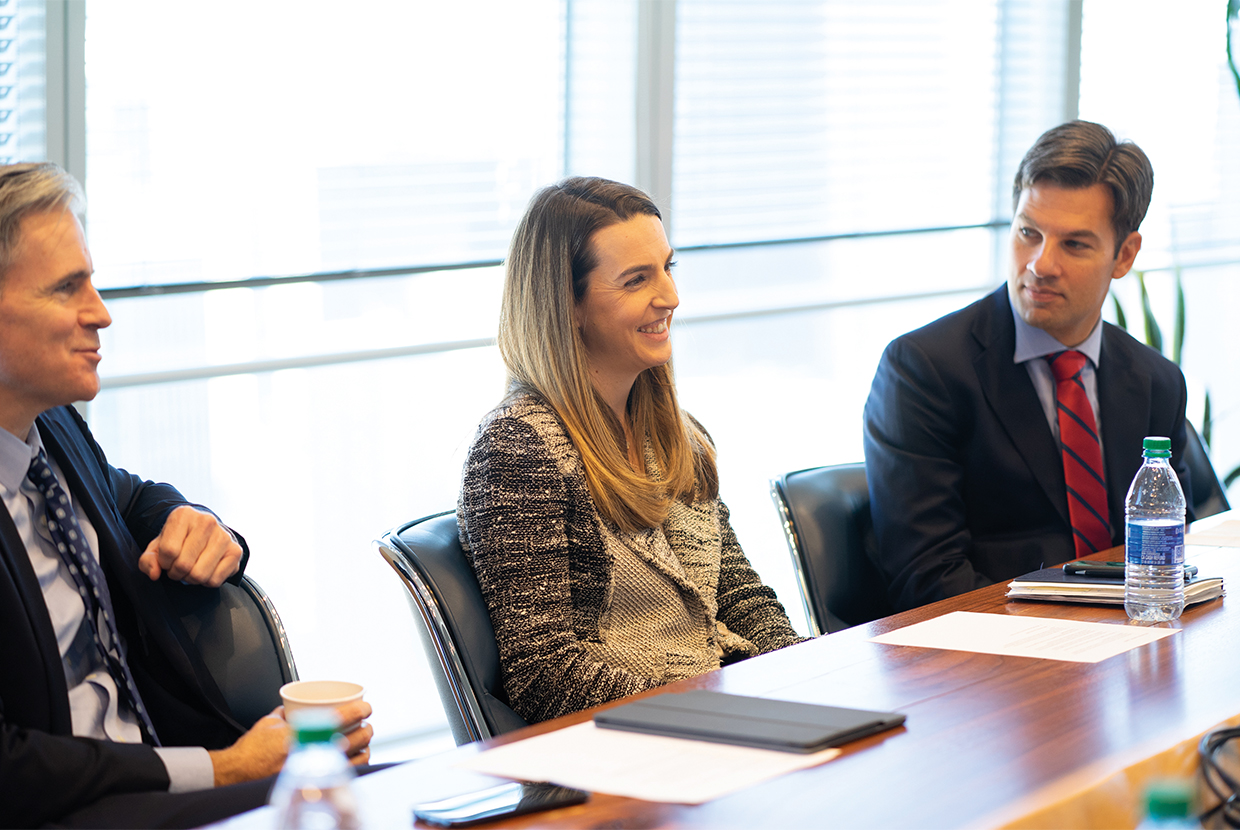In our annual US-based roundtable discussion, GTR gathered senior trade finance bankers in New York in December to talk concerns around supply chain finance; question whether or not enough collaboration is happening in the market; and evaluate the future role of banks.
Roundtable participants
- Julia Bartlett, North America trade head, Citi
- James Binns, global head of trade and working capital, Barclays
- Geoff Brady, head of global trade and supply chain, Bank of America (chair)
- Patricia Gomes, regional head, North America, global trade and receivables finance, HSBC
- Joon Kim, global head of trade product and portfolio management, treasury services, BNY Mellon
- Filipe Mossmann, head of trade sales, Americas, Standard Chartered
- Jonathan Richman, managing director, head of US trade and working capital, Santander
- Daniel Son, head of global large cap banks, global trade and supply chain finance, US Bank
Brady: What are your biggest concerns with regard to trade finance as an industry?
Binns: For me, it is the continued compression of margin. Over the last few years, trade has been a difficult business for us to meet return hurdles, and it is only getting more difficult to do so. Part of the reason for that is that you are starting to see a lot more capital markets activity in trade, and it is going to become increasingly tough to compete and to generate the returns we need to.
Richman: What keeps me up at night in the supply chain finance space is the non-bank players coming in who may not have the same standards we are accustomed to in the traditional banking space, at least from an AML or a security perspective. If one of those programmes for the non-bank players were to blow up it could impact not just how banks look at this as an asset class, but also debt rating agencies, accountants and institutional investors. And should that happen, we will all feel the impact of that, as will our clients.
Brady: What do you think we, the banking community, can do to separate the kind of trade finance we provide, and how we define it from what is going on out in the market that we might consider outside of that definition?
Richman: There are the industry initiatives underway defining best practices that we should all sign up for. Also, we need to be very selective in terms of which third parties we work with, and ensure they also abide by some set of standards that we feel is in the best interest of the industry and our clients.
Bartlett: We also need to further define what trade is. With some of these new entrants and new developments to the trade market, we are starting to see different flows. It is not just about mitigating risk between the buyer and the seller – whether it is services or payroll – we are starting to see some of these new flows being financed, and that begs the question, is this trade or is it not? If we are playing by a common set of rules, we need to define what they are, and how do they apply to these flows? Not an easy thing to define and answer, but this is one of the concerns I have, that the definition of trade seems to be a bit more fluid than it used to be.
Mossmann: Going back to the ‘fintechs as originators’ point, one aspect to be mindful of is that sometimes they have solutions that mechanically work great, but may be challenging for banks and investors to accept. For example, in an event of non-payment, it may be difficult to enforce legal rights against obligors. Most structures are yet to be stress tested. The more robust ones will likely thrive.
Kim: As trade finance bankers, we have a pretty good idea what payables financing is and what receivables financing is and what we want to accomplish. But internally, when we are trying to convince the asset class that what we are doing makes sense compared to the other asset classes, people have very limited knowledge. So, what is payables financing? How does that work versus working capital? One of the key initiatives that we are taking is having enhanced collaborations with corporate treasury, credit, and operational risk, so that they have a better understanding of what we are trying to accomplish within the trade finance world.
Binns: I believe that some have lost the wood for the trees when it comes to supply chain finance, and it is being used for the wrong reasons. In some instances it is being used for large buyers to increase their leverage on suppliers, to improve their own ratios or cash generation. From an investor standpoint, they in turn can generate returns by buying supply chain receivables. And what some have lost sight of is what supply chain finance should be about: fair and efficient allocation of capital and funding throughout the supply chain to reduce the cost of funding across supply chain ecosystems, rather than just benefitting hubs within those ecosystems. If we can come out with a set of principles that actually takes us back to why we should be doing supply chain finance in the first place, and then stick to those principles as a group of banks, that would be a really good start in helping to create a more sustainable and responsible model.
Brady: Joon, you touched on this point about education, and we all do a bit of internal as well as external education. Do you think that there is harmony among regulators, accounting standards boards and banks’ internal credit decision-makers around what banks define as payables finance or supply chain finance? Or do you think there is still a difference of opinion as to what this business is?
Kim: People who are not involved in trade finance on a daily basis think of it as a type of working capital loan, and think it must be similar to a commercial loan or a money market placement. So they cannot really differentiate the value. To address that, we have to communicate that these are transactions that have an underlying movement of goods. They are short-term, self-liquidating and, to a large extent, bilateral. We have done reasonably well at this at our bank. Corporate treasury has a much greater appreciation for the assets we are generating, and there is a bigger push at our bank today – because of the interest rate environment and the liabilities coming in – to grow the assets.
Binns: The regulators could help more here, because if they allow us to change our models, to recognise our risk-weighted assets for trade business, that will then start to change behaviour in terms of how we all operate as well.
Brady: It can be difficult to change mindsets internally when there may be a difference of opinion externally.
Richman: We have made progress. If I look back a few years ago before there was an ICC loss registry, a loan was treated the same as trade for risk and capital purposes, and there was very little differentiation. Today, we have come some distance. Some regulators get it. Just like within banks, some risk people get it and some don’t.
The bigger issue is when you look at the next level down; there is not enough distinction between what is a good practice and what is a bad practice for payables and other programmes. So, people know what a payables programme is, but I don’t think that rating agencies, accountants, and regulators would agree on what best practice looks like and when the boundaries are pushed too far and the risks are too high.
Bartlett: This scenario exists within financial institutions, and applies to clients as well. We need to ensure there is a joint framework that both can refer to and adhere to.
Brady: Do we do enough collaborating as an industry around this? Do we speak with one voice as much as we should?
Gomes: I’m going to say no. And it’s not just in this. If you think about how we are actually going to reap the benefits of blockchain, for example, it comes through collaboration, and we don’t do enough of it. I know we have various industry bodies, whether it’s the ICC or Baft, but we need to activate that more. Certainly around the supply chain finance topic, the suggestion that Jonathan made around having some kind of Equator Principles that we as an industry could sign up to would be very beneficial.
Binns: That would be great, because it would then start to put us in the headlights of the regulators as being responsible, and that enables us to then start having more dialogue with them. I am not sure that regulators understand our sector properly. They read negative things about certain supply chain programmes, and they immediately associate that with being supply chain finance more generally, and they forget that the majority of the industry is quietly getting on with it in the right way.
Brady: How do clients feel about this type of financing? Are we still seeing the same level of appetite for supply chain financing even given the noise that might be out in the industry?
Kim: Definitely yes. I totally agree with Patricia. The collaboration is not there. If you search Google for ‘what is a letter of credit’, you get a pretty definitive idea of what a letter of credit is. Type in ‘supply chain financing’ or ‘working capital’, and you find 29 different definitions of what they are. That we can’t come up with a general definition of ‘supply chain’ confuses the whole landscape as to what it is that a bank is offering in terms of supply chain, versus another bank that is offering, say, ‘payables financing’. This is something we need to resolve. Once we have a high-level definition, clients will have a much better understanding of what supply chain financing is and the requirements they need to express to bankers.
Binns: As a practical point in terms of what I am picking up from clients: if you are a large company being asked to join a supply chain finance programme by a lot of different buyers, you are then having to do different technical connections and sign different RPAs, and some companies are getting fed up with having multiple different supply chain finance programmes and platforms that they need to connect to as a large supplier. If there is a solution that we can find as a group where there is a standardised RPA, for example, that will start to help the industry as well. That is one practicality that maybe we have some power over.
Richman: We need to define our role as banks in all of this, whether it is as structurers, onboarders, platform providers, etc. Regulated bank balance sheets are not the cheapest source of funding: it is a source of funding that is reliable and probably needs to be there in some form, but it won’t be the primary source, in my view, over time. We need to deal with these kinds of issues by working with new investors.
Brady: One important thing banks have always brought to the table is the relationship with their clients: buyers, sellers, and sometimes both. The non-bank investor community isn’t always interested in a relationship. Often they don’t want to be in the treasurer’s office, they look to the banks for that.
So, what is the best role for us banks five years from now? And to another point that Filipe touched on, we see technology providers and fintechs these days as collaborators as well as competitors. Where do we see that partnership five years from now? Have we figured out that collaboration entirely?
Richman: It’s a journey that we are on, and there are many chapters of the story still to be written. It’s impossible to say what role all banks should play in general, because they are all different. The leading trade banks will play a more comprehensive role as perhaps a platform provider, co-liquidity provider, bringing investors and embedding capital markets solutions, onboarding capabilities and so forth. The question with second-tier banks is what role will they play? They will need to find a niche, building on some strengths, whether it is their client relationships, or product or geographic strength; I think their role is still to be defined. The big global trade banks have a general idea as to what their role is going to be, but over time, the role of just being the primary funder is going to diminish, and we need to be comfortable with that reality.
Bartlett: It is also a question of what happens with the economy. Trade providers, including banks and fintechs, have benefited from strong growth following the financial crisis, but will that continue if we experience another crisis or economic event? Citi collaborates with fintechs through Citi Ventures across many business lines, including trade. These partnerships have enabled us to provide more competitive solutions to our clients. But through this fintech collaboration we are continuously reminded that it’s important to have a very disciplined approach to giving non-regulated organisations access to information – to bank data, client treasury systems, mission-critical stuff. If we begin to operate in a more challenging economic environment, we need to ensure the partners we have chosen can continue to operate alongside the banks. Chances are not all of the newer entrants to the market would survive a financial crisis, which is something we all need to be mindful of.
Richman: I totally agree. Not only the economy and the longevity of some of these fintechs, but the compliance risks that they run, things that we – and our regulators – may not consider to be acceptable within banking. The playing field is not level, and any one of these kinds of events, the absence of UCC filings, whatever it is, can disrupt the industry in a major way.
Gomes: There is a role for everyone to play. And the question is, what is the role of the banks versus the fintechs? Certainly client relationships, that is very central to the role of the banks. Structuring is also very central to the role of the banks, and we are seeing the changing landscape of what needs to be financed in trade, with the rise of trade in services meaning that new structures need to be developed. Banks understand the clients, we understand the industry and we understand the space.
So, relationships and structuring, absolutely. And funding, to the extent that you want some element of stability of funding in terms of the partners that you choose. The traditional pyramid, right? You have bank relationships at the bottom, then you add in some non-bank relationships, insurance companies, asset managers, et cetera. There is still a role for the relationship banks to provide that initial level of funding, and then bring in investors that are interested in the asset class.
On platforms, I know that there is a lot of talk about how we want to own the platform and that is where all the traffic happens. I am very sceptical about the role of the banks being that of the platform owner for various reasons. Number one is that big supply chain programmes actually want multi bank providers – there needs to be a convergence of platforms that can create that optionality and integration. Furthermore, technology development is not our primary purpose, and we need to focus on our strengths: trusted client relationships, compliance and safekeeping of cash. Technology development is a focus for fintechs.
Kim: Regarding the role of banks five years from today, there is going to be a behavioural change, to the extent that structuring the relationship is going to be a core mission of what bankers do. But there will be much more enhanced collaboration among financial institutions. If Bank of America, for example, wants to create a billion-dollar supply chain financing programme, it is unlikely they will want to keep the billion dollars on the balance sheet. They will need partners to participate, and this is why we will have increased collaboration among banks compared to 10 years ago, when it was more a case of ‘let’s keep everything to ourselves, and not disclose anything’.
Brady: What should our collective goal be around the use cases and the value of blockchain and distributed ledger technology, and what should we be focusing our efforts around as we get involved in the consortia that we participate in?
Richman: Rather than speak about specific technology, I would say our goals in working as consortia should be around multi-bank platforms. Our clients want access to multiple banks without multiple connections. They want us to help increase connectivity in the wider sphere, whether it is to different ecosystems or supplier groups, and to work together in areas where we don’t try to differentiate, where we are not competing with each other. The work we have done together with OCR technologies in the compliance space is a good example.
There are a lot of blockchain-specific initiatives. I have not seen a case yet where the benefits are so compelling that you must use that technology, where the benefits outweighed that very significant effort, and multiple parties that need to be involved to deliver the benefits. I’m not saying it won’t happen, I just haven’t seen it yet. But there is no question that you will see more multi-bank and automation-related efforts regardless of the technology that is being used.
Gomes: Data consistency, standards across the board, not dividing the industry into islands, and collaboration are so important. At some point the consortia need to speak to each other, so we need to ensure that.
There are use cases not just in the open account space, but also in the traditional trade space. One of the biggest frustrations for me is that trade is still so paper-based. My biggest worry is the missed opportunity of not getting our act together: we need to do so because the technology is there.
We have done a number of live transactions at HSBC in the traditional trade space where we have taken the processing of an import/export transaction from an average of two weeks down to several hours. That is a real benefit. Companies can ship more. It’s going to be critical for the industry. It is revolutionising and it is mission-critical for us to adopt it.
The challenge is, how do we get all the parties in the trade ecosystem on it? It is not just banks, it is regulators, customers, as well as transport and logistics providers.
Mossmann: You touch on a critical point, which is the regulation supporting trade. We can have the best platform systems, involving all the banks and clients, but it is vital that countries locally also evolve in their requirements for paper and rubberstamp to release cargoes or wet ink to bind legal agreements, then we can fully reap the benefits of digitisation.
Binns: That is going to be the critical part. You are absolutely right, how do we get paper out of the system?
Gomes: OCR is going to be crucial. We have deployed sanctions and AML automation and it is running really well. The amount of efficiency that you get by not having people looking at manual pieces of paper and ticking off red flags is tremendous.
Son: There is a practical reality in executing these initiatives. We all have priorities, and we are all fighting for investment dollars. We know that there are clear benefits to creating alliances and developing standards. The more – as a consortium, as a unified body – we can push for standardisation and scale, the easier it will be for internal stakeholders to commit to these initiatives.
Binns: Having a more focused approach on certain sectors is going to be key. If you look at the commodities sector, for example, komgo is making reasonable progress at the moment, and for me, the main reason for that is being driven by the client. It is not being driven by banks or technology companies. And if we can get around sectors like that and work with those clients who are driving those solutions to prove it is working, then the ball will start rolling elsewhere, and you will start to get that momentum flowing.
Bartlett: You asked what the goal should be. The goal should be impact. We’re at a stage now where we all want to show we are innovating, we all want to chase new projects or technologies, and what we need to do is ensure that they are bringing the impact.
We need to be honest with ourselves, and ensure that our results are consistent with the investments we are making. If they are not, we all need to address collectively, what is working in the industry, whether it is komgo or something else, and what is not, and direct our focus and resources accordingly. It is very easy to chase things and get down a path where you lose sight of the main goal. Whether we are giving clients what they want, or optimising internal processes, we need to keep sight of the overall impact of the effort.
Brady: Are we seeing the landscape materially change because of what is going on in trade around the world with treaties, tariffs, etc? Do we see an impact, and if so, what is that impact on the way our clients behave and therefore how we have to serve our clients?
Son: For our US-based clients, the domestic market has always been a core market for them. One change we are seeing is that customers who previously wanted to explore selling more internationally are just doing more of the same, which is selling domestically. The US economy is still fairly resilient, so their perception is that they are kind of shielded from all the things that are happening. Clients have also been pretty agile in terms of looking at other markets where there is less impact from a trade war.
Richman: There is a much higher level of awareness of this risk now compared to a year or two years ago. What a lot of clients have realised is just how difficult it is to change integral parts of their supply chain that have been established.
There is no question there is a lot of effort to try to diversify sourcing markets and sales markets, but it doesn’t happen overnight. A lot of clients are now trying to make sure that they have more contingency plans. It has actually made our role more important as a trade finance provider, and adviser from a risk perspective, as well as a liquidity provider helping to set up new relationships with new trading partners in new markets. It has made us more important. So, I view it as an opportunity to really help our clients more than we did a few years ago before all of this happened.
Binns: The thing that I am interested in looking at is how technology will begin to impact manufacturing going forwards. As you start to see 3D printing develop, to what extent will certain sectors start localising production with third parties? The cross-border element then becomes more of an IP element, which is a code that is released to the 3D printer to manufacture the item in the country where it is going to be consumed. And then our model starts to change as well, because obviously, we are financing cross-border IP as part of trade, rather than the movement of physical goods and services. Obviously, it’s a way off, but it’s interesting to start thinking about.
Gomes: Whilst I agree with everything that has been said, and I certainly agree with the opportunity that it creates for us to add value and advise clients, I don’t want to be laissez-faire about some of the concerns as well.
The element of uncertainty that has been brought about by the shifting trade policy landscape cannot be minimised, and neither can the impact that it is having on investment, whether it is foreign direct investment or indeed manufacturing and capex. We speak to a lot of clients that are postponing investment decisions, and that has an impact in terms of the economic growth cycle. We cannot discount that, and that is going to impact our business, naturally.
And the other element that I don’t want to gloss over is that with all of these negotiations, we have seen that some of the bigger clients, the multinationals that have more negotiating power, can either press tariff costs up into the supplier, or they can absorb that cost in their margin. But you do have some smaller corporate clients that operate on very thin margins and do not have the purchasing power, that are actually folding the tent. And so there is going to be a credit impact for certain clients.
Brady: What are your areas of focus for 2020?
Kim: The biggest project for us is the Ibor transition. The phasing out of Libor in December 2021 is a big headache for the trade finance business because we need to do a daily compound on an overnight basis: system changes, tax purposes financing, collaborating with the corporate contracts, fallback languages, et cetera. So we are already hiring a number of outsiders to make sure that we comply, and that we have the capability to do so. That is going to be our priority.
Son: Our 2020 focus continues to be on growth and optimisation – but in a way that’s in line with the bank’s strategy and direction.
Richman: Three things, I would say. One is product development in our core receivables and payables finance products, whether it is about embedding FX conversion, using data to take risk earlier in the finance process etc. Number two would be around distribution and capital models and using our balance sheet for maximum efficiency from both capital and credit perspectives. The third would be around increasing end-to-end automation and efficiency.
Gomes: Our rallying cry internally at HSBC is ‘Trade Transformation’, which is the hundreds of millions of dollars of investment that we are putting in to transform the business. 2020 will continue in that journey. It has three elements. It has a customer element – we talked about new structures and financing trade in services, which is different from trading goods – so adapting to new customer needs. It has an element of re-structuring the way we do our business, and it has a whole element around new technology deployment, whether it is interacting with blockchain or through APIs, but also AI.
Mossmann: The three key areas of focus for trade at Standard Chartered in the Americas in 2020 will be the same as we have been focusing on in 2019, where we made good progress. These are the use of new technologies to improve and increase the amount of business we do, both by process automation and data-driven decision support.
We also had a goal of leading more syndicated deals and enhancing our distribution capabilities, and in 2019 we were able to close a few key deals in that area, ending the year with a strong pipeline for 2020.
Lastly, participating on platforms’ or other banks’ supply chain finance programmes. We see that as an opportunity when it is driven by our clients.
An overarching theme of attention is around environmental sustainability, and how trade can be a robust conduit for funds to flow from environmentally concerned investors into the supply chain. The impact can be quick and relevant. We see a lot of focus with our clients, especially in the C-suite. If we can find a way to work together, banks, investors, clients, and some other players in the market, we can have a tremendous impact beyond just the traditional trade finance.
Bartlett: Citi’s global trade business has some new leadership, myself included, and we will continue to evolve and refine our strategy in 2020. As a veteran of Citi’s trade business, I can say that we will continue to look to partner with clients as strategic working capital advisors, really focusing on solutions that add value both to them and to us. We are really looking to originate and execute transactions and solutions structured with our intellectual property, focusing on the trade of the future, if you want to call it that.
Certainly, there is also a continued focus on efficiency. We have been huge adopters of OCR and artificial intelligence, more so on the traditional trade services side of the business. In 2020 we have a long list of projects that we will continue on that front to optimise the business that we have today.
Binns: For me, the first is to continue our journey of becoming a trusted advisor to our clients. The second is upgrading our core technology, re-platforming so we become connectable and digitally enabled in the future. And the third is to grow our suite of sustainable trade products.
Brady: From a Bank of America perspective, the focus will be on efficiency and product development, and being able to rally together the concept of payables and receivables and being able to use AI and data to sort a receivable into something we want to fund, something we want to distribute, or something that we want to structure into a securitisation. The ease of use from a client perspective as well as the ease of use from a receivable comes to the bank and the bank makes a decision.













